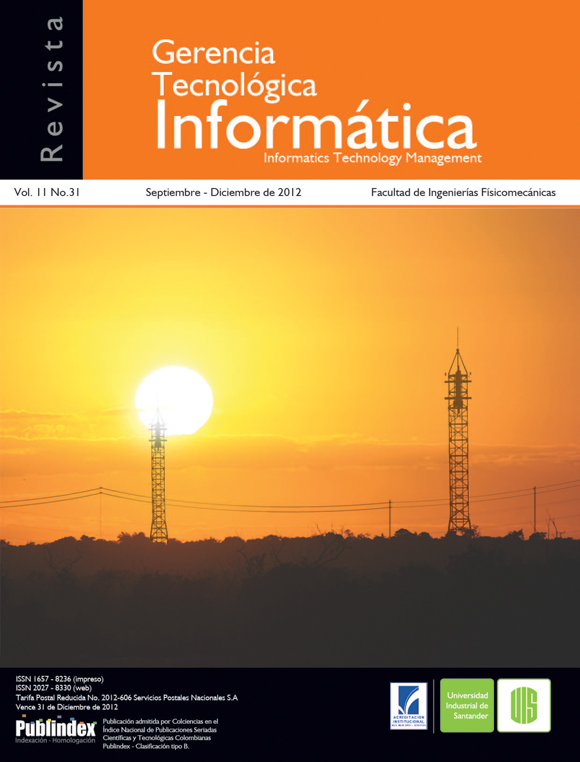ESTUDIO DE TECNOLOGÍAS PARA IMPLANTAR TELEFONÍA IP EN UNA ORGANIZACIÓN
Published 2013-02-27
How to Cite
Abstract
RESUMEN ANALÍTICO
La telefonía IP es la transmisión en tiempo real de voz, también conocida como VoIP, y otros datos multimedia, a través de redes que utilizan el protocolo de internet (IP). Esta tecnología ofrece la posibilidad de reducir los costos en la comunicación, eliminando la necesidad de adquirir hardware adicional. En los últimos años el uso de la telefonía IP ha aumentado considerablemente, haciendoque cada día sean más los proveedores que brindan este servicio. Por esta razón, se manifiesta la necesidad de analizar los proveedores que se encuentran en el mercado, como un paso previo a la implantación del servicio en cualquier organización. En este documento, se presenta un estudio de los proveedores que existen actualmente a nivel internacional, analizando parámetros como el precio del minuto, la documentación disponible en la web, la posibilidad de hacer llamadas simultáneas y de crear un sistema IVR. Como resultado del análisis, a nivel nacional, no se encontraron proveedores que ofrezcan una Interfaz de Programación de Aplicaciones (API por sus siglas en inglés). También se considera que “Tropo” es una plataforma que satisface los requisitos establecidos en el estudio y se destaca frente a las demás.
PALABRAS CLAVES: Telefonía IP, VoIP, Tropo, SIP, IVR
STUDY OF TECHNOLOGIES TO IMPLEMENT IP TELEPHONY IN AN ORGANIZATION
ANALYTICAL SUMMARY
IP telephony is the transmission in real time of voice, also known as VoIP, and other multimedia data through networks using the internet protocol (IP). This technology offers the possibility of reducing communication costs, and eliminating the need to buy additional hardware. In recent years the use of IP telephony has increased considerably, having to have more providers who provide this service. For this reason, it manifests the necessity of analyzing the vendors that are in the market as a previous step in implementing the service in any organization. In this document, it presents a study of providers that currently exist at an international level; taking parameters such as the price per minute, the documentation available on the web, the possibility of making simultaneous calls and create an IVR system. As a result of the analysis, at a national level, there are not providers offering an Application Programming Interface (API). Also it is considered that “Tropo” is a platform that satisfies the established requirements set out in the study and it stands out in front of others.
KEYWORDS: IP Telephony, VoIP, Tropo, SIP, IVR
Downloads
References
- PARRA, Andrés, GUERRERO, Fabio. Esquema de redundancia y distribución de carta de alta disponibilidad para la prestación de telefonía IP usando SIP. Revista Avances en Sistemas e Informática, Vol. 6, p 7-14. Medellín: Junio de 2009.
- FERRÁEZ R., Emilio. El impacto de la telefonía IP en las organizaciones. Xalapa-Enríquez, Veracruz, 2008, 111 p. Trabajo de grado (Licenciado en sistemas computacionales administrativos). Universidad Veracruzana. Facultad de Contaduría y Administración.
- BORGES, Isabel, BOUCADAIR, Mohamed, NEVES, Pedro Miguel, EINARSSON, Ólafur Páil. IP Telephony Interconection Reference: Challenges, Models, and Engineering. Boca Raton: CRC Press, 2012. 390 p.
- ROSENBERG, J., SCHULZRINNE, H., CAMARILLO, G., JOHNSTON, A., PETERSON, J., SPARKS, R., HANDLEY, M., and SCHOOLER, E. SIP: Session Initiation Protocol. Junio 2002. (Citado: 6 de septiembre de 2012). Disponible en: http://tools. ietf.org/html/rfc3261
- VILAR SANCHIS, Mateo. El futuro en VoIP.H.323 frente a SIP y algunas consideraciones sobre ENUM. Revista Bit, No 143. Madrid: Colegio oficial ingenieros de telecomunicación 2004.
- PATEL, P. B. y MARWALA, T. Interactive Voice Response Field Classifiers. En: IEEE International Conference on Systems, Man and Cybernetics. (2008: Singapur).
- KOK CHOONG, Ong. Hoiio. (Citado: 6 de septiembre de 2012). Disponible en: http://developer.hoiio. com/
- LAWSON, Jeff. Twilio. (Citado: 6 de septiembre de 2012). Disponible en: http://www.twilio.com/
- BATES, Tony. Skype (Citado: 6 de septiembre de 2012). Disponible en: http://developer.skype.com/ [10] TAYLOR, Jonathan. Tropo (Citado: 6 de septiembre de 2012). Disponible en: http://www.tropo.com/
- RAVISHANKER, Dinesh. CallFire (Citado: 6 de septiembre de 2012). Disponible en: http://www. callfire.com/
- TAYLOR, Jonathan. Corporación Voxeo (Citado: 6 de septiembre de 2012). Disponible en: http:// www.voxeo.com/tropo/
